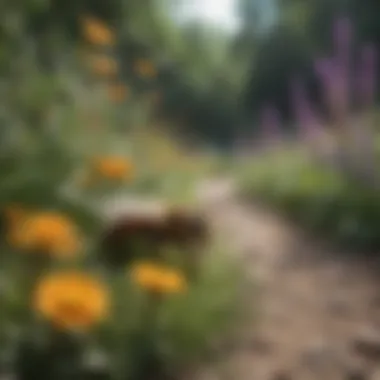Eco-Friendly Landscaping: A Comprehensive Guide to Reimagining Your Outdoor Space


Overview of the Topic
Current Status and Challenges
The current landscape paradigm predominantly features traditional grass lawns, which pose challenges such as high water consumption, chemical fertilizers, and limited biodiversity. These issues contribute to environmental degradation and unsustainable land management practices, creating a pressing need for transformative solutions in landscaping.
Sustainable Solutions
The article delves into sustainable landscaping practices, offering a repertoire of solutions to address the challenges associated with traditional grass lawns. From xeriscaping to native plant landscaping, readers explore innovative approaches aimed at promoting water conservation and ecological diversity. Additionally, the guide features case studies showcasing successful implementation of sustainable landscaping alternatives, highlighting their effectiveness in resource management.
Impact and Importance
An in-depth analysis of the impact of landscaping choices on ecosystems, communities, and future generations is presented. The article underscores the importance of conservation efforts and sustainable resource utilization in fostering environmental resilience. By emphasizing the significance of eco-conscious landscaping practices, the narrative aims to inspire conservationists, students, and environmentalists to pave the way for a greener, more sustainable future.
Introduction
The significance of this topic lies in its potential to revolutionize our approach to landscaping practices. As society continues to witness the effects of climate change and resource depletion, the need for sustainable solutions becomes ever more pressing. By delving into the process of replacing grass with environmentally friendly alternatives, this guide paves the way for a more conscious and eco-friendly landscaping paradigm.
Moreover, the benefits of transitioning from traditional turf to sustainable landscaping options extend far beyond mere aesthetics. Water conservation, a cornerstone of modern environmental practices, finds its roots in the reduction of water consumption through the cultivation of drought-resistant plants and xeriscaping techniques. Through the implementation of these methods, individuals can not only decrease their ecological footprint but also contribute to the preservation of precious water resources.
Furthermore, biodiversity enhancement emerges as another vital aspect of replacing grass with more diverse plant species. By embracing native plants and creating pollinator-friendly gardens, individuals can foster rich ecosystems within their own outdoor spaces. This not only supports local flora and fauna but also plays a pivotal role in restoring ecological balance at a time when biodiversity loss is a critical global concern.
In essence, the Introduction sets the stage for a comprehensive exploration of sustainable landscaping alternatives and serves as a catalyst for readers to embark on a transformative journey towards a greener, more environmentally conscious future.
Benefits of Replacing Grass
Replacing grass in your landscape offers a multitude of benefits that go beyond mere aesthetics. By transitioning to alternative landscaping options, you can significantly contribute to water conservation efforts and enhance biodiversity in your surroundings. This section will delve deeper into the importance of exploring sustainable alternatives to traditional grass lawns.
Water Conservation
Water conservation is a crucial aspect of sustainable landscaping. Drought-resistant plants play a pivotal role in reducing water consumption while still maintaining a green environment. These plants have unique qualities that make them well-suited for regions with limited water availability.


Drought-Resistant Plants
Drought-resistant plants have evolved to thrive in arid conditions, requiring minimal watering compared to traditional grass species. Their ability to survive with limited moisture makes them a practical choice for water-conscious landscaping. The key characteristic of these plants is their adaptability to dry climates, making them an ideal solution for sustainable landscaping projects.
Xeriscaping Techniques
Xeriscaping techniques further enhance water conservation efforts by utilizing principles such as efficient irrigation and soil management. By integrating xeriscaping into your landscape design, you can minimize water wastage while promoting plant health. This method not only reduces water consumption but also fosters resilient plant growth in varying environmental conditions.
Biodiversity Enhancement
Creating a biodiverse landscape is essential for supporting local ecosystems and wildlife. Introducing native plant species and establishing pollinator-friendly gardens can significantly enhance the biodiversity of your outdoor space, providing habitats for diverse flora and fauna.
Native Plant Species
Native plant species are indigenous to a particular region, making them well-adapted to the local climate and soil conditions. By incorporating native plants into your landscape, you can support biodiversity by attracting native wildlife and promoting ecosystem stability. Their unique features contribute to a sustainable ecosystem while requiring minimal maintenance.
Pollinator-Friendly Gardens
Pollinator-friendly gardens are designed to attract and sustain pollinating insects such as bees and butterflies. These gardens provide essential nectar and pollen sources for pollinators, supporting their populations and fostering plant reproduction. By including pollinator-friendly plants in your landscape, you can create a vibrant ecosystem that benefits both wildlife and the environment.
Sustainable Landscaping Options:
In this extensive guide on transforming landscapes, sustainable landscaping options play a pivotal role. By exploring alternatives beyond traditional grass lawns, individuals can significantly impact the environment positively. Sustainable landscaping offers a myriad of benefits, with water conservation and biodiversity enhancement being at the forefront. Opting for rock gardens, wildflower meadows, and artificial turf not only reduces water consumption but also promotes a thriving ecosystem within your surroundings.
Rock Gardens:
Alpine Rock Gardens: Alpine rock gardens stand out for their unique ability to thrive in harsh conditions. These gardens typically feature plants that are well-adapted to high altitudes and rocky terrain. The key characteristic of alpine rock gardens lies in their resilience to extreme temperatures and minimal water requirements. This resilience makes them a popular choice for sustainable landscaping, offering a visually appealing and low-maintenance option for diverse environments. Despite their charm, alpine rock gardens may pose challenges in terms of limited plant selection and initial establishment.
Dry Stacked Stone Features: Dry stacked stone features bring a touch of natural artistry to landscapes while serving practical purposes. These features involve arranging stones without mortar, creating stunning visual displays. The key characteristic of dry stacked stone features is their durability and timeless elegance. They are a favored choice for their sustainable aspect, requiring minimal maintenance and blending seamlessly with various design themes. However, incorporating dry stacked stone features may involve skilled labor and can be costly due to material sourcing and installation intricacies.
Wildflower Meadows:


Meadow Seed Mixes: Meadow seed mixes add a burst of color and diversity to landscapes, emphasizing a more naturalistic approach. The key characteristic of meadow seed mixes is their ability to attract pollinators and support local wildlife. These mixes are favored for their ecologically sound properties, contributing to the overall health of the ecosystem. While meadow seed mixes offer a stunning meadow-like appearance, they demand proper soil preparation and regular maintenance to thrive optimally.
Butterfly Habitat Gardens: Butterfly habitat gardens are tailored to cater to the needs of these delicate pollinators. The key characteristic of butterfly habitat gardens is their strategic selection of plants that attract and sustain butterflies throughout their life cycle. These gardens not only enhance the aesthetics of a landscape but also play a vital role in conserving butterfly populations. However, maintaining a butterfly habitat garden requires attention to detail and a keen understanding of butterfly-friendly plant species. Additionally, they may require extra effort to prevent pest infestations.
Artificial Turf:
Polyethylene Grass: Polyethylene grass offers a synthetic yet eco-friendly alternative to natural grass. The key characteristic of polyethylene grass is its durability and low maintenance requirements. This type of artificial turf is renowned for its natural look and feel, making it a popular choice for sustainable landscaping projects. Polyethylene grass comes with the advantage of being water-efficient and resistant to harsh weather conditions. However, installation costs and potential heat retention issues are factors to consider before opting for this synthetic grass variety.
Recycled Materials: Utilizing recycled materials in landscaping projects is a sustainable choice with multiple benefits. The key characteristic of recycled materials is their eco-conscious approach, contributing to waste reduction and environmental preservation. Incorporating recycled materials adds a unique touch to landscape design while promoting resource efficiency. This sustainable option appeals to environmentally conscious individuals looking to minimize their ecological footprint. However, sourcing high-quality recycled materials and ensuring proper integration into landscaping features may require additional effort and expertise.
Design Considerations
In the realm of landscape transformation, design considerations play a pivotal role in shaping the overall aesthetic and functionality of the outdoor space. When delving into the process of replacing traditional grass with sustainable alternatives, the importance of design considerations cannot be overstated. By meticulously planning every aspect of the landscape design, one can achieve a harmonious blend of beauty, functionality, and eco-friendliness. From color schemes to texture variations, every decision contributes to the overarching goal of creating a sustainable and visually appealing environment.
Color Schemes
Contrast and Harmony
Contrast and harmony within color schemes act as the cornerstone of a well-balanced landscape design. The juxtaposition of different hues and tones creates visual interest and depth, while the concept of harmony ensures a cohesive and unified look. In the context of this article, contrasting colors can be strategically used to draw attention to focal points or delineate different areas within the landscape. On the other hand, harmonious color palettes evoke a sense of tranquility and balance, enhancing the overall visual impact of the outdoor space. The unique feature of contrast and harmony lies in their ability to evoke specific emotions and visually guide observers through the landscape. Leveraging this fundamental principle can elevate the aesthetic appeal of the sustainable landscape while fostering a sense of visual intrigue.
Seasonal Variation
Seasonal variation adds a dynamic element to landscape design, reflecting the ever-changing tapestry of nature throughout the year. By incorporating plants with varying blooming seasons or foliage colors, one can ensure that the landscape remains visually engaging regardless of the time of year. In the context of this article, seasonal variation offers a practical approach to maintaining aesthetic appeal continuously. While certain plants may bloom in spring or summer, others may exhibit vibrant foliage colors in the fall. This diversity ensures that the landscape evolves with the seasons, injecting a sense of vitality and transformation into the outdoor space. The key advantage of emphasizing seasonal variation lies in its ability to create a dynamic and visually rich environment that continually evolves, captivating both residents and visitors with its ever-changing beauty.
Texture and Height
Layered Plantings
Layered plantings offer a multi-dimensional approach to landscape design, creating depth and visual interest through the strategic arrangement of vegetation. By incorporating plants of varying heights and textures, one can construct visually dynamic compositions that emulate the complexity of natural ecosystems. In the context of this article, layered plantings not only enhance the aesthetic appeal of the landscape but also contribute to biodiversity by accommodating diverse plant species and microhabitats. The unique feature of layered plantings lies in their ability to mimic natural plant communities, fostering ecological resilience and creating a visually engaging environment that evolves over time.
Ornamental Grasses


Ornamental grasses serve as versatile and low-maintenance additions to sustainable landscapes, offering a unique blend of texture, color, and movement. Their graceful foliage and architectural form add a distinctive aesthetic element to the outdoor space, complementing other plantings and hardscape features. In the context of this article, ornamental grasses provide visual contrast and seasonal interest, with some species exhibiting vibrant fall colors or winter textures. The advantage of incorporating ornamental grasses lies in their ability to thrive in a variety of conditions while requiring minimal inputs, making them ideal for eco-conscious landscaping designs that prioritize both aesthetics and sustainability.
Maintenance Practices
Maintenance practices play a crucial role in sustainable landscaping and are key to the success of transforming your landscape from traditional grass lawns. By implementing proper maintenance techniques, you can not only enhance the beauty of your outdoor space but also contribute to water conservation and biodiversity. Weed control and irrigation are vital aspects of maintenance practices that require careful attention and planning. Ensuring that your landscaping is well-maintained will also save you time and effort in the long run.
Weed Control
Weed control is essential for the health and aesthetics of your landscape. By effectively managing weeds, you can prevent them from competing with your desired plants for resources and ensure a thriving environment. There are two main strategies for weed control: mulching and natural weed suppressants.
Mulching Strategies
Mulching is a popular and effective weed control method that involves covering the soil around plants with a protective layer of organic material. This helps to inhibit weed growth by depriving them of sunlight and smothering them. Mulching also helps retain moisture in the soil, regulate soil temperature, and improve soil health. Choosing the right type of mulch for your landscape, such as wood chips, straw, or shredded bark, can significantly reduce the time and effort spent on weed management.
Natural Weed Suppressants
Natural weed suppressants are organic substances or plants that can help deter weed growth naturally. These suppressants typically release chemicals or compounds that inhibit weed germination and growth. Utilizing natural weed suppressants such as mulch from organic materials, like compost or leaf mold, can not only control weeds but also enrich the soil with valuable nutrients. Implementing natural weed suppressants in your landscaping practices promotes a healthy ecosystem and reduces the need for synthetic herbicides.
Irrigation Techniques
Proper irrigation is essential for the health and vitality of your plants, especially when transitioning to sustainable landscaping alternatives. Two effective irrigation techniques to consider are drip irrigation systems and rainwater harvesting methods.
Drip Irrigation Systems
Drip irrigation systems deliver water directly to the roots of plants, minimizing water wastage and evaporation. This targeted approach ensures that plants receive adequate moisture without excess water runoff. Drip irrigation systems are efficient, eco-friendly, and easily customizable to suit different plant varieties and garden layouts. By optimizing water distribution, drip irrigation systems help conserve water resources and promote plant growth while reducing weed proliferation.
Rainwater Harvesting Methods
Rainwater harvesting involves collecting and storing rainwater for later use in irrigation. This sustainable practice reduces dependency on traditional water sources, lowers water bills, and mitigates stormwater runoff. Implementing rainwater harvesting methods, such as rain barrels or underground cisterns, allows you to utilize natural precipitation to nourish your landscape. By harnessing rainwater, you not only support water conservation efforts but also increase self-sufficiency and resilience in your landscaping endeavors.
Conclusion
In the grand scheme of transforming your landscape, the Conclusion serves as the pivotal endpoint, encapsulating the essence of this exhaustive guide on Replacing Grass. It acts as the culminating chapter, consolidating key takeaways and driving home the significance of adopting sustainable alternatives in modern landscaping practices. By delving into the repercussions of maintaining traditional grass lawns versus embracing eco-conscious substitutes, this section aims to enlighten readers about the paramount importance of making informed choices that not only benefit the environment but also lend a touch of uniqueness to their outdoor spaces.
One of the primary facets underscored in this Conclusion is the imperative need to shift from conventional landscaping norms towards more sustainable methodologies. As environmental concerns take center stage globally, the exploration of eco-friendly alternatives such as Wildflower Meadows, Rock Gardens, and Artificial Turf becomes more than a mere suggestion—it morphs into a call to action. This guileless narrative dives deep into the intricate nuances of sustainable land management, advocating for a harmonious coexistence with nature while elevating the visual appeal of outdoor spaces to unprecedented heights.
Furthermore, the Conclusion dissects the overarching benefits of bid adieu to traditional grass lawns. From Water Conservation principles to Biodiversity Enhancement strategies, the article meticulously deconstructs how each element contributes to a holistic, eco-conscious landscaping approach. By unpacking the significance of reducing water consumption, supporting native plant species, and creating pollinator-friendly habitats, readers are invited to reevaluate their landscaping choices through a lens tinted with environmental consciousness and sustainability.
Lastly, the Conclusion encapsulates a holistic view of landscape transformation, steering individuals towards a paradigm shift that prioritizes the planet's well-being alongside visual aesthetics. This conclusive segment acts as a guiding beacon, offering readers a roadmap laced with knowledge, inspiration, and feasible actions to embark on a journey towards a landscape that echoes not only beauty but also sustainability.



